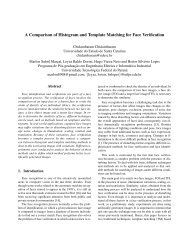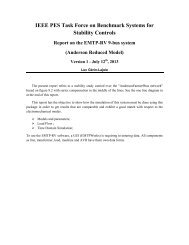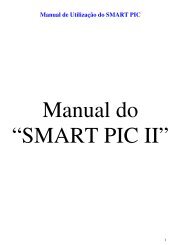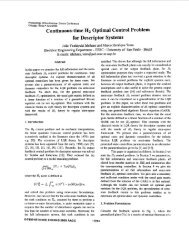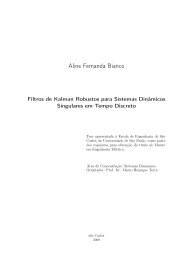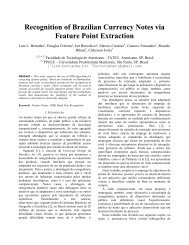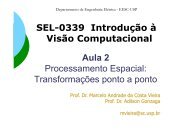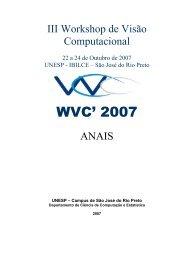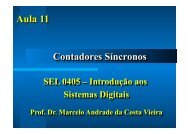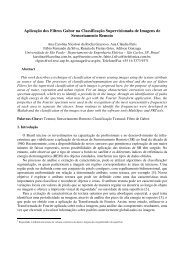ANAREDE/PacDyn/ANATEM
ANAREDE/PacDyn/ANATEM
ANAREDE/PacDyn/ANATEM
- No tags were found...
You also want an ePaper? Increase the reach of your titles
YUMPU automatically turns print PDFs into web optimized ePapers that Google loves.
IEEE PES Task Force on Benchmark Systems forStability ControlsReport on the 9-bus system (Anderson-Farmer Model)Version 1 - November 5 th , 2012Rodrigo A. Ramos, Roman Kuiava, Tatiane C. C. Fernandes, Liciane C. Patacaand Moussa R. MansourThe present report refers to a small-signal stability study carried over the Anderson-Farmermodel using the Anarede/<strong>PacDyn</strong>/Anatem package from CEPEL. This report has the objectiveto show how the simulation of this system must be done using this package in order to getresults that are comparable (and exhibit a good match with respect to the electromechanicalmodes) with the ones presented in the website www.sel.eesc.usp.br/ieee 1 . To facilitate thecomprehension, this report is divided in three sections (according to the software to be used):‣ Load Flow (<strong>ANAREDE</strong>);‣ Small-Signal Stability Assessment via Eigenvalue Calculation (<strong>PacDyn</strong>);‣ Numerical Simulation of the Nonlinear Model (<strong>ANATEM</strong>);1. Load FlowThe load flow of the Anderson-Farmer was calculated using the <strong>ANAREDE</strong> software. Boththe input file (for the correct initialization of the software) and the obtained results are givenbelow in sections 1.1 and 1.2.1.1 Input FileTo use the <strong>ANAREDE</strong> software, an input file was produced containing the data on thetopology of the system. In this input file, presented in Appendix A (and also available fordownload at the website), loads were modeled as constant power elements and the voltagegroups to which each of the buses in the system belong were specified. Furthermore, it is in the1 In the following along the text, when the authors refer to "the website", the meaning is the webpagewww.sel.eesc.usp.br/ieee, which is the provisional website for storage of the data produced by the work ofthe IEEE PES Task Force on Benchmark Systems for Stability Controls.
2Report9 BUS SYSTEM (Anderson-Farmer Model)input file that the algorithm for load flow calculation is defined. In this case, Newton's methodwas chosen.The <strong>ANAREDE</strong> software also allows the user to build the one-line diagram of the systemfrom the data contained in the input file, which enables a clearer identification of the location ofthe buses and understanding of the results obtained with the load flow calculation. In Figure 1 itis possible to visualize this one-line diagram together with the load flow results. However, theseresults will be more clearly presented in the next subsection.Figure 1: One-line diagram of the 9 bus system with the load flow results.1.2 ResultsThe results obtained by this load flow calculation can be analyzed from Table 1. Whencomparing these results to the ones provided in the website, it is possible to observe a very goodmatch between them. The only difference refers to a standard from <strong>ANAREDE</strong>, which presentsresults with a precision up to the first decimal place, while the website gives results with aprecision up to the second decimal place. In spite of that, considering typical approximationsfrom the second to the first decimal place, the level of agreement of the results is almostcomplete.Table 1: Results of the load flow calculation for the Anderson-Farmer systemGenerator Load ShuntBus V[pu] Angle[Deg] P[MW] Q[MVAR] P[MW] Q[MVAR] Q[MVAR]1 1.030 8.8 41,000.0 11,006.9 0.0 0.0 0.02 1.050 6.9 12,000.0 207.7 0.0 0.0 0.03 1.032 17.9 3,780.0 511.7 0.0 0.0 0.04 1.020 0.0 49,104.1 15,617.1 0.0 0.0 0.05 1.012 4.3 0.0 0.0 40,000.0 8,000.0 0.06 1.040 2.8 0.0 0.0 500.0 100.0 0.07 1.021 -7.9 0.0 0.0 2,750.0 550.0 844.18 1.025 13.8 0.0 0.0 1,750.0 200.0 0.09 1.000 -3.9 0.0 0.0 50,000.0 12,000.0 0.0
Report9 BUS SYSTEM (Anderson-Farmer Model)3From the result of the load flow (which gives information for the calculation of theequilibrium point of the system), it is possible to apply a set of techniques involvinglinearization to analyze the local, small-signal stability of the system through the calculation ofthe eigenvalues of the state matrix of the linearized system model. This procedure is carried outby the <strong>PacDyn</strong> software and is presented in the next section.2. Small-Signal Stability Analysis of the SystemTo use the <strong>PacDyn</strong> software for assessment of the small-signal stability of the Anderson-Farmer system, two input files are necessary. One of them contains the topological data of thesystem and the results of the load flow calculation, while the other contains the types of models,the structures and the parameters of the generators and its associated controllers. The former isobtained as an output file from the <strong>ANAREDE</strong> software in the “*.his” or “*.sav” formats. Thelatter, containing the dynamic data for the system, must be constructed and saved in the “*.dyn”format. This format is described in more detail in section 2.1, while section 2.2 presents theresults of the whole study.2.1 The input file with the dynamic data for the systemIn the input file containing the dynamic data for the system (the “*.dyn” file) the models torepresent the generators in the system must be chosen, and the controllers for each respectivemachine must be either chosen as built-in models or defined by the user with a particular syntax.For this study, the details on the model of the generators and its respective controllers arepresented in the sequence:a) GeneratorsThe Anderson-Farmer model is composed by 4 generators, where generators 1 and 4 arethe equivalents of a group of generators located in areas 2 and 3, respectively. According to thewebsite information, generators 1 and 4 can be described by a classical (2 nd order) model, whilegenerators 2 and 3 must be represented by a 6 th order model. The equations for the 2 nd and 6 thorder models, presented with details in the website, are repeated here (so the reader can assessthe differences between these equations and the ones available in <strong>PacDyn</strong>):‣ 2 nd order model(1)(2)(3)(4)
4Report9 BUS SYSTEM (Anderson-Farmer Model)‣ 6 th order model(5)(6)(7)(8)(9)(10)0 = + (11)0 = - (12)0 = (13)0 = (14)The <strong>PacDyn</strong> software provides 8 different built-in models to describe a synchronousmachine. Among them, model #1 is the closest to the 2 nd order model given in the website forgenerators 1 and 4, while model #5 is the closest to the 6 th order model for the other generators.Model #1 is composed by the set of equations (20) – (23), which are presented below. Somedifferences can be observed between (1) – (4) and (20) – (23), most notably with respect to theuse of the subtransient impedances x ’ d and x ’ q. We believe that these differences are one of themain reason for certain discrepancies between the results gotten from <strong>PacDyn</strong> and the onesgiven in the website, as will be seen later.(15)(16)(17)(18)(19)(20)(21)(22)
Report9 BUS SYSTEM (Anderson-Farmer Model)5(23)Model #5 is composed by the set of equations (24)-(31), constituting the 6 th order modelgiven below:(24)(25)(26)(27)(28)(29)(30)(31)In Figure 2, it is possible to visualize the manner in which the generator data are insertedinto the input file. The complete input file for this study is given in Appendix B and is alsoavailable for download at the website.(31)Figure 2: Specification of Generator Model and Data in <strong>PacDyn</strong>.
6Report9 BUS SYSTEM (Anderson-Farmer Model)b) ControllersThe controllers implemented in the input file follow the specifications given in the website.All generators in this system are equipped with speed governors and voltage regulators.However, only generators 2 and 3 are equipped with PSSs, since generators 1 and 4 areequivalent models of larger groups of machines. To facilitate the comprehension of this reportby the reader, the block diagrams of each controller model is repeated in Figures 3, 4, 5 and 6,but they can also be retrieved from the website.‣ Voltage regulator• Generators 1 and 4Figure 3: Model of the voltage regulator for generators 1 and 4• Generators 2 and 3Figure 4: Model of the voltage regulator for generators 2 and 3‣ Speed governorsFigure 5: Model of the speed governors present in all 4 generators of the system
Report9 BUS SYSTEM (Anderson-Farmer Model)7‣ PSS (only for generators 2 and 3)Figure 6: Model of the PSS for generators 2 and 3To illustrate how the block diagrams are inserted into the input file, the part of this filerelated to the speed governor and to the voltage regulator are presented in Figure 7, while Figure8 presents the part of this file related to the insertion of the PSS. All controllers presented inFigures 7 and 8 are related to generator 2.Figure 7: Specification of the structure and data for the speed governor and voltage regulatorof generator 2 in <strong>PacDyn</strong>
8Report9 BUS SYSTEM (Anderson-Farmer Model)Figure 8: Specification of the structure and data for the PSS of generator 2 in <strong>PacDyn</strong>.2.2 ResultsThe results obtained by <strong>PacDyn</strong> on the small-signal stability analysis of the Anderson-Farmer model can be seen in Tables 2, 3 and 4. In Table 2, a comparison between theelectromechanical modes given by <strong>PacDyn</strong> with the ones given by the website is presented.Note that the values related to the inter-area mode in Table 2 were taken from Version 1,dated August 31st, 2012, which is the original version of the website that was hosted at theUniversity of Wisconsin-Madison.Table 2: Comparison between the electromechanical modes calculated by <strong>PacDyn</strong> and the onesgiven in the website.Eigenvalues from the WebsiteEigenvalues from <strong>PacDyn</strong>Mode Real Imag f(Hz) ζ(%) Real Imag f(Hz) ζ (%)Local #1 -2.9176 8.8756 1.413 31.228 -2.8406 8.9134 1.4185 30.364Local #2 -1.5324 5.5312 0.880 26.699 -1.5816 5.4274 0.8638 27.977Inter-area -0.1813 1.5676 0.250 11.40 -0.0448 1.5059 0.2397 2.9738To facilitate the comparison, Table 3 presents the absolute deviations between the two setsof results given in Table 2.Table 3: Absolute deviations between the two sets of results in Table 2.Local Mode #1 Local Mode #2 Inter-area modeSource f(Hz) ζ(%) f(Hz) ζ(%) f(Hz) ζ(%)Website 1.4130 31.228 0.8800 26.699 0.250 11.40<strong>PacDyn</strong> 1.4185 30.367 0.8638 27.978 0.2397 2.975AbsoluteDeviation0,0055 0,8610 0,0162 1,279 0,0103 8,425It is possible to notice the the only major discrepacy is related to the results for the interareamode. However, Version 1 of the website stated that "The last eigenvalue represents adominant interarea mode with frequency 0.25Hz. Since we do not adopt PSSs to generator1 and 4, this mode is poorly damped." This is not consistent with the result reported in this
Report9 BUS SYSTEM (Anderson-Farmer Model)9same version, because the damping ratio of the inter-area mode in this case is 11.4%.Therefore, given that the results obtained from <strong>PacDyn</strong> are more consistent with thisaffirmative (providing a damping ratio of approximately 3% for the inter-area mode),Version 2 of the website (dated August 30th, 2012) presents the results from <strong>PacDyn</strong>instead of the ones given in the previous version of the website. This remains to beconfirmed by the analysis of the results of the Anderson-Farmer model using othersoftware as well.Together with the electromechanical modes, all the other eigenvalues of the state matrix ofthe system linearized model are presented in Table 4, where it is possible to compare theeigenvalues calculated by <strong>PacDyn</strong> with the ones given in the website. The values highlighted inred are the ones that were found in only one of the sources.3. Numerical Integration of the Nonlinear ModelTo validate the results of the linearized analyzes presented in the previous section, a fewsimulations of the dynamic response of the systems to certain perturbations were simulated vianumerical integration of the nonlinear equations composing the system model, using the<strong>ANATEM</strong> software. In this section, the machine and controller models used in thesesimulations, as well as a set of results from one of the mentioned simulations, are presented.To use the <strong>ANATEM</strong> software, a main input file must be built containing information suchas the operating point of the system and the data corresponding to the gerenators and itsrespective controllers. Analogously to the <strong>PacDyn</strong> software, the equilibrium point is providedby the “*.his” or “*.sav” files generated by the <strong>ANAREDE</strong> software. The generator andcontroller models used for simulation of the Anderson-Farmer system are presented in thesequence. The complete model files for the execution of the <strong>ANATEM</strong> software can be seen inAppendix C, and can also be retrieved from the current version of the website.3.1. Generator Modelsa) Generators 1 and 4To model generators 1 and 4, a classical machine model (composed by a voltage source inseries with the direct axis transient reactance of the generator) was used. This is a pre-definedmodel that is available within the <strong>ANATEM</strong> software.The block diagram representing this model is presented in Figure 8.Figure 8 - Block diagram of the model for generators 1 and 4 in the <strong>ANATEM</strong> sofware.
10Report9 BUS SYSTEM (Anderson-Farmer Model)It is important to remark here that this built-in machine model in <strong>ANATEM</strong>does NOT allow any type of control over the generator. In other words, even if onemodels the voltage regulators and speed governors for these two generators in<strong>ANATEM</strong> using the classical machine model of Figure 8, these controllers will bedisabled by the software for the simulation. Thus, it is expected that somediscrepancies between the plots presented in this report and the ones given in thewebsite appear.The parameters retrieved from the website to set up the representation of generators1 and 4 are presented in Table .Table 5 - Synchronous machine parameters for the model of generators 1 and 4.Symbol Definition Units Generator 1 Generator 4S Generator MVA Rating MVA 60,000 70,000H Inertia Constant s 2.318 3.930D Damping Coefficient p.u.* 2.0 2.0Armature Resistance p.u.* 0.0046 0.0010Direct-axis Transient Reactance p.u.* 0.28 0.22*p.u. : On the Generator Rated MVA Baseb) Generators 2 and 3For generator 2 and 3, another pre-defined model (this time for a round rotor machine withone field winding and three damper windings, one of them being along the direct axis and theother two along the quadrature axis) was used. This pre-defined model is presented in Figures 9(swing equations), 10 (direct axis equations) and 11 (quadrature axis equations).Figure 9: Block diagram for the swing equation of the model for generators 2 and 3.
Report9 BUS SYSTEM (Anderson-Farmer Model)11Table 4: Comparison between eigenvalues associated to the Anderson-Farmer system calculated by<strong>PacDyn</strong> and given in the website.Website<strong>PacDyn</strong>Real Imag f(Hz) ζ(%) Real Imag f(Hz) ζ(%)-0,181 1,5676 0,249 11,489 -0,045 1,506 0,240 2,974-1,532 5,531 0,880 26,699 -1,582 5,427 0,864 27,978-2,918 8,876 1,413 31,228 -2,841 8,913 1,419 30,364-162,038 172,841 27,508 68,394 -161,480 173,360 27,591 68,159-163,800 131,164 20,875 78,058 -163,890 139,710 22,236 76,101-1,181 0,544 0,087 90,827 -1,150 0,576 0,092 89,402-13,484 30,251 4,815 40,712 --- --- --- ----13,440 31,028 4,938 39,746 --- --- --- ----0,231 0,385 0,061 51,450 --- --- --- ----62,974 --- --- 100,000 -62,206 --- --- 100,000-53,312 --- --- 100,000 -53,260 --- --- 100,000-30,525 --- --- 100,000 -30,302 --- --- 100,000-26,001 --- --- 100,000 -26,003 --- --- 100,000--- --- --- --- -25,000 --- --- ------ --- --- --- -25,000 --- --- ----21,134 --- --- 100,000 -21,074 --- --- 100,000-17,550 --- --- 100,000 -17,624 --- --- 100,000-5,000 --- --- 100,000 -5,000 --- --- 100,000-5,000 --- --- 100,000 -5,000 --- --- 100,000-5,000 --- --- 100,000 -5,000 --- --- 100,000-5,000 --- --- 100,000 -5,000 --- --- 100,000-5,000 --- --- 100,000 -5,000 --- --- 100,000-5,000 --- --- 100,000 -5,000 --- --- 100,000-5,000 --- --- 100,000 -5,000 --- --- 100,000-5,000 --- --- 100,000 -5,000 --- --- 100,000-3,471 --- --- 100,000 -3,095 --- --- 100,000-2,413 --- --- 100,000 -2,560 --- --- 100,000-2,500 --- --- 100,000 -2,500 --- --- 100,000-2,500 --- --- 100,000 -2,500 --- --- 100,000-1,303 --- --- 100,000 -1,335 --- --- 100,000-1,020 --- --- 100,000 -1,026 --- --- 100,000-0,231 --- --- 100,000 -0,333 --- --- 100,000-0,333 --- --- 100,000--- --- --- --- -0,320 --- --- 100,000-0,997 --- --- 100,000 --- --- --- ----0,980 --- --- 100,000 --- --- --- ----0,105 --- --- 100,000 --- --- --- ----0,102 --- --- 100,000 -0,102 --- --- 100,000-0,456 --- --- 100,000 --- --- --- ----0,050 --- --- 100,000 -0,050 --- --- 100,000-0,050 -0,047 --- --- 100,0000,000 --- --- --- -0,004 --- --- ---
12Report9 BUS SYSTEM (Anderson-Farmer Model)Figure 10: Block diagram for the direct axis equations of the model for generators 2 and 3.Figure 11: Block diagram for the quadrature axis equations of the model for generators 2 and 3.In this simulation the saturation curves of the generators were not represented.The parameters retrieved from the website for generators 2 and 3 using these models arepresented in Tables 6 and 7.
Report9 BUS SYSTEM (Anderson-Farmer Model)13Table 6: Time constants for generators 2 and 3Symbol Time Constant Units Generator 2 Generator 3t' do d-axis Transient s 5.690 5.900t'' do d-axis Subtransient s 0.041 0.033t' qo q-axis Transient s 1.500 0.540t'' qo q-axis Subtransient s 0.144 0.076Table 7: Other parameters for generators 2 and 3Symbol Definition Units Generator 1 Generator 2 Generator 3 Generator 4S Generator MVA Rating MVA 60 1,3 4,4 70H Inertia Constant s 2.318 2.642 3.960 3.930D Damping Coefficient p.u.* 2.0 2.0 2.0 2.0r a Armature Resistance p.u.* 0.0046 0.0019 0.0031 0.0010x l Armature Leakage Reactance p.u.* 0.155 0.246 0.110 0.135x d Direct-axis Reactance p.u.* 2.110 2.183 1.700 1.790x' d Direct-axis Transient Reactance p.u.* 0.280 0.413 0.245 0.220x'' dDirect-axis SubtransientReactancep.u.* 0.215 0.339 0.185 0.180x q Quadrature-axis Reactance p.u.* 2.020 2.157 1.640 1.715x' qQuadrature-axis TransientReactancep.u.* 0.490 1.285 0.380 0.400The synchronous machine models are provided within the file 4GENERATOR.blt,presented in Appendix C and available for download at the website.3.2. Controller modelsThe controller models were defined by the users via the execution code DCDU and aregiven in the file 4GENERATOR.cdu, also presented in Appendix C. These models and itsparameters were also retrieved from the website, and were already presented in Figures 3, 4, 5and 6 of this report.3.3. Resultsa) Perturbation dataThe applied perturbation was a three-phase fault in line C (which connects buses 7 and 6, ascan be seen in the one-line diagram given in the website), with a duration of four 60 Hz cycles(or approximately 0.0067s). As mentioned in the website, the proximity of the fault to bus 6 was0% (in other words, the fault was applied directly at the bus), to facilitate the simulation.
14Report9 BUS SYSTEM (Anderson-Farmer Model)b) SimulationThe total simulation time was 10 s and the integration step was 0.01 s. The angle ofgenerator 4 was taken as a reference for angle differences, to enable a comparison with theresults presented in the website. The main input file 9bus_<strong>ANATEM</strong>.stb used in the simulationis presented in Appendix C and can also be downloaded from the website.The angle difference graphs for generators 1, 2, 3 and 4 are presented in Figures 12, 13, 14and 15, respectively.Figure 12: Rotor angle of generator 1 with respect to generator 4.Figure 13: Rotor angle of generator 2 with respect to generator 4.
Report9 BUS SYSTEM (Anderson-Farmer Model)15Figure 14: Rotor angle of generator 3 with respect to generator 4.Figure 15: Rotor angle of generator 4 with respect to itself.The rotor frequency graphs for generators 1, 2, 3 and 4 are presented in Figures 16, 17,18 e 19, respectively.Figure 16: Rotor frequency of generator 1.
16Report9 BUS SYSTEM (Anderson-Farmer Model)Figure 17: Rotor frequency of generator 2.Figure 18: Rotor frequency of generator 3.Figure 19: Rotor frequency of generator 4.
Report9 BUS SYSTEM (Anderson-Farmer Model)17When these plots are compared to the ones given in the website, a visual similarity can beobserved. Until now it was not possible to plot the results given in the website for thesesimulations due to a difficulty in detecting which are the data sets corresponding to each plot,but the authors expect that this will be provided in the next versions of this report. Somediscrepancies are expected, again due to the differences in the types of models used for thegenerators, mainly with repect to generators 1 and 4.4. ConclusionsAs a conclusion of this first study on the small-signal stability of the Anderson-Farmermodel, we can see that the results obtained with the <strong>ANAREDE</strong>/<strong>PacDyn</strong>/<strong>ANATEM</strong> packageexhibit a satisfactory similarity to the ones provided in the website www.sel.eesc.usp.br/ieee.This similarity is observed in the electromechanical modes, which are the main focus of thisTask Force.The only issue that was observed was the difference in the damping ratio related to theinter-area mode, which the authors believe to have been incorrectly presented in the first versionof the website, given that one of the statements made in this version contradicts the presentedresult, while the result found by the authors of this report is consistent with this statement.However, this remains an open issue since no other confirmation or rebuttal was offeredby the teams working with other software packages. With the progress of the work of this TaskForce, we expect to clarify this issue and finish the validation of the 9-bus system (Anderson-Farmer model) as a benchmark for small-signal stability studies.As a suggestion for future work, we also point out that modal estimation techniquescould be applied to the results of the nonlinear simulations attempting to provide furthervalidation in the identification of the electromechanical modes.
Appendix AIn this appendix, the input file necessary for the correct initialization of the <strong>ANAREDE</strong>software is presented. In Figure A-1 it is highlighted how the loads must be modeled as constantpower elements and how the voltage groups of the buses must be set up, so the user can getmatching results with the ones provided in the website.Identification ofthe voltage groupof the busesidentificadosLoads modeled asconstant powerelementsFigure A-1: Input file for the <strong>ANAREDE</strong> software with the data for the load flow calculation.
Appendix BIn this appendix, the input file “*.dyn” with the dynamic data used for the eigenvaluecalculation in the <strong>PacDyn</strong> software is presented. To run the <strong>PacDyn</strong> software, this file must beloaded together with the “*.his” output file provided by the <strong>ANAREDE</strong> software. In Figures B-1, B-2 and B-3 it is possible to see the entire “*.dyn” input file that was produced for the smallsignalstability analysis of the Anderson-Farmer model.Figura B-1: Insertion of the system data, all generator data and AVR models for generators 1 and 2.
20 AppendixesFigure B-2: Insertion of the AVR models for generators 3 and 4 and PSSs for generators 2 and 3.
Appendixes 21Figure B-3: Insertion of the speed governor models for all generators.
Appendix CThe main input file 9bus_<strong>ANATEM</strong>.STB used in the <strong>ANATEM</strong> software for nonlinearsimulation of the Anderson-Farmer model is given in Figures C-1a and C-1b.In this file, the associations with the files of steady-state operation (*.sav) from<strong>ANAREDE</strong>, pre-defined machine models (*.blt) and user-defined controllers (*.cdu) aredepicted. This main file also contains the data for the applied perturbation and the associationwith the output file (*.plt) that contains the output variables of interest: rotor angle andfrequency of all generators.Figure C-1a : Main file (*.stb) - part 1.
Appendixes 23Figure C-2b : Main file (*.stb) - part 2.The input file 4GENERATOR.blt that is used in the <strong>ANATEM</strong> software for nonlinearsimulation of the Anderson-Farmer model is given in Figure C-2.
24 AppendixesFigure C- 2: File with the generator models (*.blt)The file 4GENERATOR.cdu that is used in the <strong>ANATEM</strong> software for defining thecontroller models is given from Figure C-3 to Figure C-7.
Appendixes 25Figure C-3: Models of voltage regulators for generators 1 and 4 (part 1 of the *.cdu file)
26 AppendixesFigure C-4: Models of voltage regulators for generators 2 and 3 (part 2 of the *.cdu file)
Appendixes 27Figure C-5: Models of PSSs for generators 2 and 3 (part 3 of the *.cdu file)
28 AppendixesFigure C-6: Models of speed governors for generators 1, 2 and 3 (part 4 of the *.cdu file)
Appendixes 29Figure C-7: Model of the speed governor for generator 4 (part 5 of the *.cdu file)




